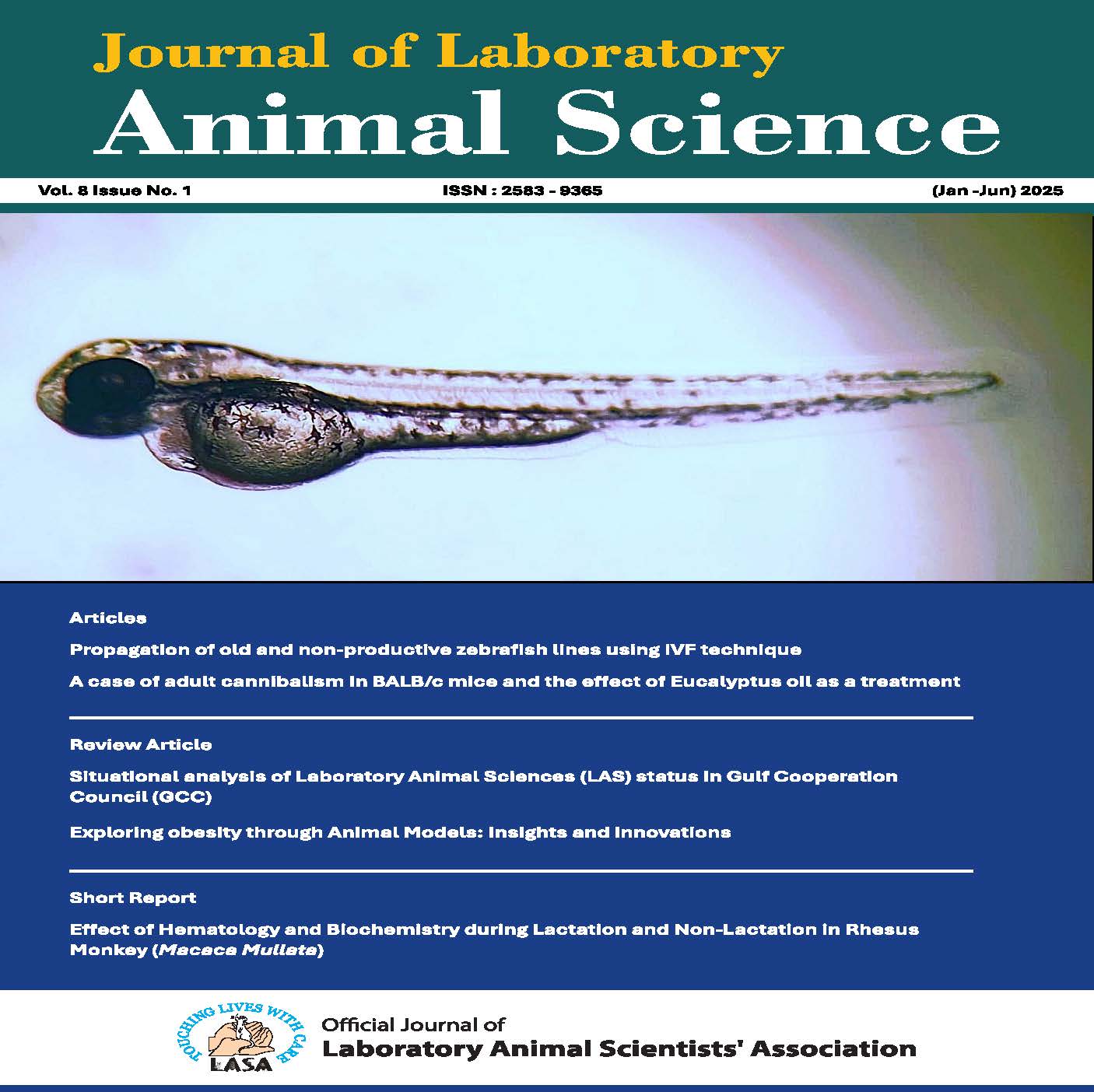Status of laboratory animal welfare in India: a way forward
DOI:
https://doi.org/10.48165/jlas.2023.6.2.4Keywords:
Laboratory animal welfare, Status, India, Way forwardAbstract
Laboratory animals are being used widely in the research and development organizations and hence their welfare is of a great concern. The welfare of laboratory animals varies in a continuum between the countries in the world and are linked to their cultural, societal and religious practices. There is a need for very good laboratory animal welfare in India and also countries for the advancement of scientific knowledge and benefit of the human kind. The status of the welfare of the laboratory animals used for research in India was discussed and also the way forward is explained.
Downloads
References
1. API (2020). Animal Protection Index https://api. worldanimalprotection.org/. Accessed on 22nd December 2021.
2. Badyal D.K and Desai C (2014). Animal use in pharmacology education and research: The changing scenario. Indian J Pharmacol. 46(3): 257–265.
3. Bayne K and Anderson L C (2015). Laws, regulations, and policies affecting the use of laboratory animals. In Laboratory Animal Medicine, ed. J G Fox, L C Anderson, G M Otto, K R Pritchett-Corning, and M T Whary, 3rd edition, Elsevier, San Diego, p 23–43.
4. Broom D.M (1986). Indicators of poor welfare. British Vet J. 142: 524 -526.
5. Carlstead K (1996). Effects of Captivity on the Behavior of Wild Mammals. Wild Mammals in Captivity Principles and Techniques, University of Chicago, pp 317–333.
6. CPCSEA (2018). Compendium of Committee for the purpose of control and supervision of Experiments on animals (CPCSEA) under Ministry of Environment, Forest and Climate Change, Government of India, New Delhi.
7. Gilbert S F, Sapp J and Tauber I A (2012). A Symbiotic View of Life: We Have Never Been Individuals. Q Rev Biol. 87(4): 325–341.
8. Fraser A F and Broom D M (1997). Farm Animal Behavior and Welfare, 3rd edition, CAB International, London, UK.
9. Harikrishnan V S, Hansen A K, Abelson K S P and Sorenson D B (2018). A comparison of various methods of blood sampling in mice and rats: Effects on animal welfare. Lab. Anim. 52(3): 253–264.
10. Hessler J R (1999). The history of environmental improvements in laboratory animal science: Caging systems, equipment, and facility design. In Fifty Years of Laboratory Animal Science, ed. C.W. Mc Pherson and S.F. Mattingly, Memphis: American Association for Laboratory Animal Science, pp: 92–120.
11. Mallapur A (2008). Animal Welfare research and its implications to non-human primate breeding programs: A Case Study of the Lion-tailed macaque conservation breeding program from India. Rev. Electron. Vet. 9(10b): 1–21.
12. NRC (2011). National Research Council, Guide for the care and use of laboratory animals, 8th edition, National Academic Press, Washington, DC.
13. Pereira S, Veeraraghavan P, Ghosh S and Gandhi M (2004). Animal Experimentation and Ethics in India: The CPCSEA Makes a Difference. ATLA. 32(1): 411–415.
14. Pratap K and Singh V P (2016). A Training Course on Laboratory Animal Science: An Initiative to Implement the Three Rs of Animal Research in India. ATLA. 44(1): 21–41.
15. Preetha M and Arunkumar T (2017). Animal ethics and welfare- Review. 1st National Conference on Teaching Innovations and Enhancing Learning (Arts, Science and Technology), 5(1): 108–114.
16. Sejian V, Lakritz J, Ezeji T and Lal, R (2011). Assessment methods and indicators of animal welfare. Asian J Anim Vet Adv. 6(4): 301–305.
17. Singh V P and Yadav S. 2021. Ethics, Animal Welfare and Regulation: The Indian Perspective. In: Nagarajan P, Gudde R, Srinivasan R. (eds) Essentials of Laboratory Animal Science: Principles and Practices, Springer, Singapore. p 39–51.
18. Singer P (1975). Animal Liberation- A new ethics for our treatment of Animals. Avon Books, New York.
19. Tekulapally K and Padmavathi V (2020). Knowledge and attitude of medical students toward animal research and welfare-A cross sectional study. Natl J Physiol Pham Pharmacol. 11(3): 257–262.
20. Zurlo J, Bayne K and Clark M J (2009). Adequate Veterinary Care for Animals in Research: A Comparison of Guidelines from Around the World. ILAR J. 50(1): 85–88.

